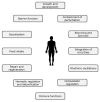Nutrition to Optimise Human Health-How to Obtain Physiological Substantiation?
- PMID: 34201670
- PMCID: PMC8308379
- DOI: 10.3390/nu13072155
Nutrition to Optimise Human Health-How to Obtain Physiological Substantiation?
Abstract
Demonstrating in an unambiguous manner that a diet, let alone a single product, 'optimizes' health, presents an enormous challenge. The least complicated is when the starting situation is clearly suboptimal, like with nutritional deficiencies, malnutrition, unfavourable lifestyle, or due to disease or ageing. Here, desired improvements and intervention strategies may to some extent be clear. However, even then situations require approaches that take into account interactions between nutrients and other factors, complex dose-effect relationships etc. More challenging is to substantiate that a diet or a specific product optimizes health in the general population, which comes down to achieve perceived, 'non-medical' or future health benefits in predominantly healthy persons. Presumed underlying mechanisms involve effects of non-nutritional components with subtle and slowly occurring physiological effects that may be difficult to translate into measurable outcomes. Most promising strategies combine classical physiological concepts with those of 'multi-omics' and systems biology. Resilience-the ability to maintain or regain homeostasis in response to stressors-is often used as proxy for a particular health domain. Next to this, quantifying health requires personalized strategies, measurements preferably carried out remotely, real-time and in a normal living environment, and experimental designs other than randomized controlled trials (RCTs), for example N-of-1 trials.
Keywords: EFSA; biomarkers; health claims; homeostasis; nutrition; resilience.
Conflict of interest statement
The author declares no conflict of interest in relation to this work.
Figures




Similar articles
-
[Current challenges of nutrition applied research: ¿person or population?].Nutr Hosp. 2018 Jun 12;35(Spec No4):39-43. doi: 10.20960/nh.2123. Nutr Hosp. 2018. PMID: 30070120 Review. Spanish.
-
The future of Cochrane Neonatal.Early Hum Dev. 2020 Nov;150:105191. doi: 10.1016/j.earlhumdev.2020.105191. Epub 2020 Sep 12. Early Hum Dev. 2020. PMID: 33036834
-
Challenging homeostasis to define biomarkers for nutrition related health.Mol Nutr Food Res. 2009 Jul;53(7):795-804. doi: 10.1002/mnfr.200800390. Mol Nutr Food Res. 2009. PMID: 19517455 Review.
-
Feeding the critically ill obese patient: a systematic review protocol.JBI Database System Rev Implement Rep. 2015 Oct;13(10):95-109. doi: 10.11124/jbisrir-2015-2458. JBI Database System Rev Implement Rep. 2015. PMID: 26571286
-
Nutritional interventions for preventing stunting in children (birth to 59 months) living in urban slums in low- and middle-income countries (LMIC).Cochrane Database Syst Rev. 2019 Jun 17;6(6):CD011695. doi: 10.1002/14651858.CD011695.pub2. Cochrane Database Syst Rev. 2019. PMID: 31204795 Free PMC article.
Cited by
-
Nature of the evidence base and strengths, challenges and recommendations in the area of nutrition and health claims: a position paper from the Academy of Nutrition Sciences.Br J Nutr. 2023 Jul 28;130(2):221-238. doi: 10.1017/S0007114522003300. Epub 2022 Oct 12. Br J Nutr. 2023. PMID: 36221317 Free PMC article. Review.
-
The Dark Pigment in the Sesame (Sesamum indicum L.) Seed Coat: Isolation, Characterization, and Its Potential Precursors.Front Nutr. 2022 Feb 28;9:858673. doi: 10.3389/fnut.2022.858673. eCollection 2022. Front Nutr. 2022. PMID: 35295915 Free PMC article.
-
Dynamic Nutrition Strategies for Anorexia Nervosa: Marker-Based Integration of Calories and Proteins.Nutrients. 2025 Jan 31;17(3):560. doi: 10.3390/nu17030560. Nutrients. 2025. PMID: 39940418 Free PMC article.
-
Microgreens-A Comprehensive Review of Bioactive Molecules and Health Benefits.Molecules. 2023 Jan 15;28(2):867. doi: 10.3390/molecules28020867. Molecules. 2023. PMID: 36677933 Free PMC article. Review.
-
Exposing telomere length's impact on malnutrition risk among older adults residing in the community: Insights from cross-sectional data analysis.PLoS One. 2024 Nov 5;19(11):e0308612. doi: 10.1371/journal.pone.0308612. eCollection 2024. PLoS One. 2024. PMID: 39499700 Free PMC article.
References
-
- Canguilhem G. Le Normal et le Pathologique. Volume 2015 Presses Universitaires de France; Paris, France: 1943.
-
- Michaëlsson K., Baron J.A., Byberg L., Höijer J., Larsson S.C., Svennblad B., Melhus H., Wolk A., Warensjö Lemming E. Combined associations of body mass index and adherence to a Mediterranean-like diet with all-cause and cardiovascular mortality: A cohort study. PLoS Med. 2020;17:e1003331. doi: 10.1371/journal.pmed.1003331. - DOI - PMC - PubMed
Publication types
MeSH terms
Substances
LinkOut - more resources
Full Text Sources
Medical

